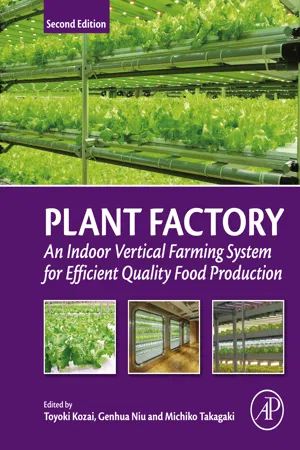
Plant Factory
An Indoor Vertical Farming System for Efficient Quality Food Production
- 516 pages
- English
- ePUB (mobile friendly)
- Available on iOS & Android
Plant Factory
An Indoor Vertical Farming System for Efficient Quality Food Production
About this book
Plant Factory: An Indoor Vertical Farming System for Efficient Quality Food Production, Second Edition presents a comprehensive look at the implementation of plant factory (PF) practices to yield food crops for both improved food security and environmental sustainability. Edited and authored by leading experts in PF and controlled environment agriculture (CEA), the book is divided into five sections, including an Overview and the Concept of Closed Plant Production Systems (CPPS), the Basics of Physics and Physiology – Environments and Their Effects, System Design, Construction, Cultivation and Management and Plant Factories in Operation.In addition to new coverage on the rapid advancement of LED technology and its application in indoor vertical farming, other revisions to the new edition include updated information on the status of business R&D and selected commercial PFALs (plant factory with artificial lighting). Additional updates include those focused on micro and mini-PFALs for improving the quality of life in urban areas, the physics and physiology of light, the impact of PFAL on the medicinal components of plants, and the system design, construction, cultivation and management issues related to transplant production within closed systems, photoautotrophic micro-propagation and education, training and intensive business forums on PFs.- Includes coverage of LED technology- Presents case-studies for real-world insights and application- Addresses PF from economics and planning, to operation and lifecycle assessment
Frequently asked questions
- Essential is ideal for learners and professionals who enjoy exploring a wide range of subjects. Access the Essential Library with 800,000+ trusted titles and best-sellers across business, personal growth, and the humanities. Includes unlimited reading time and Standard Read Aloud voice.
- Complete: Perfect for advanced learners and researchers needing full, unrestricted access. Unlock 1.4M+ books across hundreds of subjects, including academic and specialized titles. The Complete Plan also includes advanced features like Premium Read Aloud and Research Assistant.
Please note we cannot support devices running on iOS 13 and Android 7 or earlier. Learn more about using the app.
Information
Introduction
Abstract
Keywords
Table of contents
- Cover image
- Title page
- Table of Contents
- Copyright
- Contributors
- Preface
- Part 1. Overview and concept of closed plant production system (CPPS)
- Part 2. Basics of physics and physiology — Environments and their effects
- Part 3. System design, construction, cultivation and management
- Part 4. PFALs in operation and its perspectives
- Index